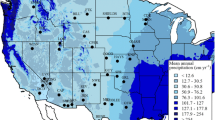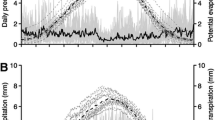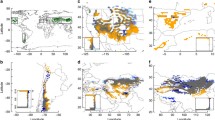Abstract
In dryland ecosystems, the timing and magnitude of precipitation pulses drive many key ecological processes, notably soil water availability for plants and soil microbiota. Plant available water has frequently been viewed simply as incoming precipitation, yet processes at larger scales drive precipitation pulses, and the subsequent transformation of precipitation pulses to plant available water are complex. We provide an overview of the factors that influence the spatial and temporal availability of water to plants and soil biota using examples from western USA drylands. Large spatial- and temporal-scale drivers of regional precipitation patterns include the position of the jet streams and frontal boundaries, the North American Monsoon, El Niño Southern Oscillation events, and the Pacific Decadal Oscillation. Topography and orography modify the patterns set up by the larger-scale drivers, resulting in regional patterns (102–106 km2) of precipitation magnitude, timing, and variation. Together, the large-scale and regional drivers impose important pulsed patterns on long-term precipitation trends at landscape scales, in which most site precipitation is received as small events (<5 mm) and with most of the intervals between events being short (<10 days). The drivers also influence the translation of precipitation events into available water via linkages between soil water content and components of the water budget, including interception, infiltration and runoff, soil evaporation, plant water use and hydraulic redistribution, and seepage below the rooting zone. Soil water content varies not only vertically with depth but also horizontally beneath versus between plants and/or soil crusts in ways that are ecologically important to different plant and crust types. We highlight the importance of considering larger-scale drivers, and their effects on regional patterns; small, frequent precipitation events; and spatio-temporal heterogeneity in soil water content in translating from climatology to precipitation pulses to the dryland ecohydrology of water availability for plants and soil biota.





Similar content being viewed by others
References
Adams DK, Comrie AC (1997) The North American monsoon. Bull Am Meteorol Soc 78:2197–2213
Aguado E, Burt JE (2004) Understanding weather and climate, 3rd edn. Prentice-Hall, Upper Saddle River
Allen CD, Breshears DD (1998) Drought-induced shift of a forest-woodland ecotone: rapid landscape response to climate variation. Proc Natl Acad Sci USA 95:14839–14842
Arritt RW, Goering DC, Anderson CJ (2000) The North American monsoon system in the Hadley centre coupled ocean-atmosphere GCM. Geophys Res Lett 27:565–568
Barry RG, Chorley RJ (1998) Atmosphere, weather and climate, 7th edn. Routledge, London
Beatley JC (1974) Phenological events and their environmental triggers in Mojave Desert ecosystems. Ecology 55:856–863
Belnap J, Lange OL (2001) Biological soil crusts: structure, function and management. Ecological studies, vol 150. Springer, Berlin Heidelberg New York
Belsky AJ, Amundson RG, Duxbury JM, Riha SJ, Ali AR, Mwonga SM (1989) The effects of trees on their physical, chemical, and biological environments in a semi-arid savanna in Kenya. J Appl Ecol 26:1005–1024
Ben-Asher J, Matthias AD, Warrick AW (1983) Assessment of evaporation from bare soil by infrared thermometry. Soil Sci Soc Am J 47:185–191
Benson L, Linsley B, Smoot J, Mensing S, Lund S, Stine S, Sarna-Wojcicki A (2003) Influence of the Pacific Decadal Oscillation on the climate of the Sierra Nevada, California and Nevada. Quat Res 59:151–159
Branson FA, Gifford GF, Renard KG, Hadley RF (1981) Rangeland hydrology, 2nd edn. Kendall/Hunt, Dubuque
Breshears DD, Barnes FJ (1999) Interrelationships between plant functional types and soil moisture heterogeneity for semiarid landscapes within the grassland/forest continuum. Landscape Ecol 14:465–468
Breshears DD, Myers OB, Johnson SR, Meyer CW, Martens SN (1997a) Differential use of spatially heterogeneous soil moisture by two semiarid woody species: Pinus edulis and Juniperus monosperma. J Ecol 85:289–299
Breshears DD, Rich PM, Barnes FJ, Campbell K (1997b) Overstory-imposed heterogeneity in solar radiation and soil moisture in a semiarid woodland. Ecol Appl 7:1201–1215
Breshears DD, Nyhan JW, Heil CE, Wilcox BP (1998) Effects of woody plants on microclimate in a semiarid woodland: soil temperature and evaporation in canopy and intercanopy patches. Int J Plant Sci 159:1010–1017
Bryson RA, Hare FK (1974) Climates of North America. Elsevier, New York, p 420
Caldwell MM, Dawson TE, Richards JH (1998) Hydraulic lift: consequences of water efflux from the roots of plants. Oecologia 113:151–161
Campbell GS, Harris GA (1981) Modeling soil-water-plant-atmosphere systems in deserts. In: Evans DD, Thames JL (eds) Water in desert ecosystems. Hutchinson & Ross, Dowden
Cane MA (1986) El Niño. Annu Rev Earth Planetary Sci 14:43–70
Cane MA, Clement AC, Kaplan A, Kushnir Y, Pozdnyakov D, Seager R, Zebiak SE, Murtugudde R (1997) Twentieth-century sea surface temperature trends. Science 275:957–960
Cayan MA, Webb RH (1992) El Niño/southern oscillation and streamflow in the western United States. In: Diaz HF, Markgraff V (eds) El Niño: historical and Paleoclimatic aspects of the southern oscillation. Cambridge, London
Corbett ES, Crouse RP (1968) Rainfall interception by annual grasses and chaparral—losses compared. FS Research Paper PSW-48. USDA, Berkeley
Dawson TE (1993) Woodland water balance. Trends Ecol Evol 8:120–121
Dettinger MD, Cayan DR, Diaz HF, Meko DM (1998) North-south precipitation patterns in western North America on interannual-to-decadal scales. J Climate 11:3095–3111
Devitt D, Smith SD (2002) Root channel macropores enhance downward movement of water in a Mojave Desert ecosystem. J Arid Environ 50:99–108
Dingman SL (1994) Physical hydrology. Prentice Hall, Upper Saddle River
Ehleringer JR, Roden J, Dawson TE (2000) Assessing ecosystem-level water relations through stable isotope ratio analysis. In: Sala O, Jackson RB, Mooney HA, Howarth RW (eds) Methods in ecosystem science. Springer, Berlin Heidelberg New York
Golluscio RA, Sala OE, Lauenroth WK (1998) Differential use of large summer rainfall events by shrubs and grasses: a manipulative experiment in the Patagonian steppe. Oecologia 115:17–25
Gray ST, Betancourt JL, Fastie CL, Jackson ST (2003) Patterns and sources of multidecadal oscillations in drought-sensitive tree-ring records from the central and southern Rocky Mountains. Geophys Res Lett 30:1316–1320
Harte J, Shaw MR (1995) Shifting dominance within a montane vegetation community: results of a climate-warming experiment. Science 267:876–880
Inouye DW, Barr WA, Armitage KB, Inouye BD (2000) Climate change is affecting altitudinal migrants and hibernating species. Proc Natl Acad Sci USA 97:1630–1633
Jackson RB, Canadell J, Ehleringer JR, Mooney HA, Sala OE, Schulze ED (1996) A global analysis of root distributions for terrestrial biomes. Oecologia 108:389–411
Jackson RB, Anderson LJ, Pockman WT (2000) Measuring water availability and uptake in ecosystem studies. In: Sala O, Jackson RB, Mooney HA, Howarth RW (eds) Methods in ecosystem science. Springer, Berlin Heidelberg New York
Jackson RB, Carpenter SR, Dahm SN, McNight DM, Naiman RJ, Postel SL, Running SW (2001) Water in a changing world. Ecol Appl 11:1027–1045
Joffre R, Rambal S (1993) How tree cover influences the water balance of Mediterranean rangelands. Ecology 74:570–582
Jorgensen DL, Klein WH, Korte AF (1967) A synoptic climatology of winter precipitation from 700-mb lows for intermountain areas of the West. J Appl Meteorol 6:782–790
Kahya E, Dracup JA (1993) United States streamflow patterns in relation to the El-Nino Southern Oscillation. Water Resour Res 29:2491–2503
Kahya E, Dracup JA (1994) The influences of Type-1 El-Nino and La-Nina events on streamflows in the Pacific-Southwest of the United States. J Climate 7:965–976
Karl TR, Williams CN, Young PJ, Wendland WM (1986) A model to estimate the time of observation bias associated with monthly mean maximum, minimum, and mean temperatures for the United States. J Climate Appl Meteorol 25:145–160
Karl TR, Trenberth KE (2003) Modern global climate change. Science 302:1719–1723
Kiladis GN, Diaz HF (1989) An analysis of the 1877–78 ENSO episode and comparison with 1982–83. Monthly Weather Rev 114:1035–1047
Leathers DJ, Yarnal B, Palecki MA (1991) The Pacific North American teleconnection pattern and United States climate. 1. Regional temperature and precipitation associations. J Climate 4:517–528
Lins HF (1997) Regional streamflow regimes and hydroclimatology of the United States. Water Resour Res 33:1655–1667
Loik ME, Harte J (1996) High-temperature tolerance of Artemisia tridentata and Potentilla gracilis under a climate change manipulation. Oecologia 108:224–231
Loik ME, Harte J (1997) Changes in water relations for leaves exposed to a climate-warming manipulation in the Rocky Mountains of Colorado. Environ Exp Bot 37:115–123
Loik ME, Redar SP, Harte J (2000) Photosynthetic responses to light for Artemisia tridentata and Erigeron speciosus under a climate warming manipulation in the Rocky Mountains. Funct Ecol 14:166–175
MartinezMeza E, Whitford WG (1996) Stemflow, throughfall and channelization of stemflow by roots in three Chihuahuan desert shrubs. J Arid Environ 32:271–287
Mantua NJ, Hare SR, Zhang Y, Wallace JM, Francis RC (1997) A Pacific interdecadal climate oscillation with impacts on salmon production. Bull Am Meteorol Soc 78:1069–1079
McCabe GJ, Dettinger MD (1999) Decadal variations in the strength of ENSO teleconnections with precipitation in the western United States. Int J Climatol 19:1399–1410
Murphy DD, Weiss SB (1992) Effects of climate change on biological diversity in western North America: species losses and mechanisms. In: Peters RL, Lovejoy TE (eds) Global warming and biological diversity. Yale University Press, New Haven, Connecticut, USA
NCDC (1994) Time bias corrected divisional temperature-precipitation-drought index. Documentation for dataset TD-9640. National Climatic Data Center, Asheville
Noy-Meir I (1973) Desert ecosystems: environment and producers. Annu Rev Ecol Syst 4:25–52
Rajagopalan B, Lall U (1998) Interannual variability in western US precipitation. J Hydrol 210:51–67
Reynolds JF, Kemp PR, Tenhuen JT (2000) Long-term rainfall variability on evapotranspiration and soil water distribution in the Chihuhuan Desert: a modeling analysis. Plant Ecol 150:145–159
Ritchie JT (1972) Model for predicting evaporation from row crops with incomplete cover. Water Resour Res 8:1204–1213
Ryel RJ, Caldwell MM, Leffler AJ, Yoder CK (2003) Rapid soil moisture recharge to depth by roots in a stand of Artemisia tridentata. Ecology 84:757–764
Sala OE, Lauenroth WK (1982) Small rainfall events: an ecological role in semiarid regions. Oecologia 53:301–304
Sala OE, Lauenroth WK, Parton WJ (1992) Long-term water dynamics in the shortgrass steppe. Ecology 73:1175–1181
Schwinning S, Sala OE (2004) Hierarchy of responses to resource pulses in arid and semi-arid ecosystems. Oecologia (in press)
Selkowitz DJ, Fagre DB, Reardon BA (2002) Interannual variations in snowpack in the crown of the continent ecosystem. Hydrol Proc 16:3651–3665
Sellars WD, Hill RH (1974) Arizona Climate 1931–1972, 2nd edn. University of Arizona Press, Tucson
Shaw MR, Loik ME, Harte J (2000) Water relations and gas exchange for two Rocky Mountain shrub species exposed to a climate change manipulation. Plant Ecol 146:197–206
Sheppard PR, Comrie AC, Packin GD, Angersbach K, Hughes MK (2002) The climate of the US Southwest. Climate Res 21:219–238
Snyder ML, Bell JL, Sloan LC, Duffy PB, Govindasamy B (2002) Climate responses to a doubling of atmospheric carbon dioxide for a climatically vulnerable region. Geophys Res Lett 29:U383–U386
Walter H (1971) Natural savannas: ecology of tropical and subtropical vegetation. Oliver and Boyd, Edinburgh
Waring RH, Running SW (1998) Forest ecosystems: analysis at multiple scales, 2nd edn. Academic Press, San Diego
Weltzin JF, Loik ME, Schwinning S, Williams DG, Fay P, Haddad B, Harte J, Huxman TE, Knapp AK, Lin G, Pockman WT, Shaw MR, Small EE, Smith MD, Smith SD, Tissue DT, Zak J (2003) Assessing the response of terrestrial ecosystems to potential changes in precipitation. BioScience 53:941–952
Wilcox BP, Breshears DD, Allen CD (2003a) Ecohydrology of a resource-conserving semiarid woodland: effects of scale and disturbance. Ecol Monogr 73: 223-239
Wilcox BP, Breshears DD, Seyfried M (2003b) Water balance on rangelands. In: Stewart BA, Howell T (eds) Encyclopedia of water science. Marcel Dekker, New York, pp 791–794
Williams DG, Ehleringer JR (1996) Carbon isotope discrimination in three semi-arid woodland species along a monsoon gradient. Oecologia 106:455–460
Wythers KR, Lauenroth WK, Paruelo JM (1999) Bare-soil evaporation under semiarid field conditions. Soil Sci Soc Am J 63:1341–1349
Yarnal B, Diaz HF (1986) Relationships between extremes of the southern oscillation and the winter climate of the Anglo-American Pacific coast. J Climatol 6:197–219
Acknowledgements
This paper resulted from discussions at the Workshop on Resource Pulse Effects In Arid and Semi-Arid Ecosystems, 2–4 August 2002 in Tuscon, Arizona, USA. The authors thank Cathy Smith of the NOAA-CIRES Climate Diagnostics Center for help with state climate division data. D.D.B. received support from Los Alamos National Laroratory—Directed Research and Development Funds.
Author information
Authors and Affiliations
Corresponding author
Rights and permissions
About this article
Cite this article
Loik, M.E., Breshears, D.D., Lauenroth, W.K. et al. A multi-scale perspective of water pulses in dryland ecosystems: climatology and ecohydrology of the western USA. Oecologia 141, 269–281 (2004). https://doi.org/10.1007/s00442-004-1570-y
Received:
Accepted:
Published:
Issue Date:
DOI: https://doi.org/10.1007/s00442-004-1570-y




